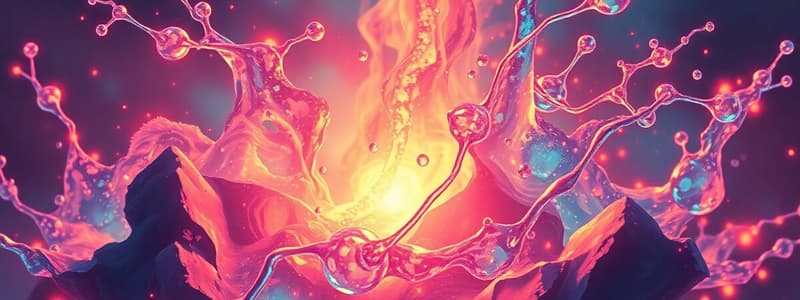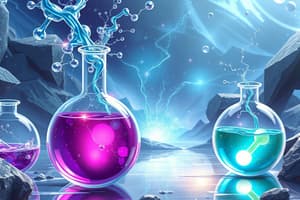Podcast
Questions and Answers
How does the amount of solute compare between a concentrated and a dilute solution?
How does the amount of solute compare between a concentrated and a dilute solution?
- Both solutions have the same amount of solute, but the concentrated solution has less solvent.
- A concentrated solution has a larger amount of solute relative to the solvent, while a dilute solution has a smaller amount. (correct)
- Both solutions have the same amount of solvent, but the dilute solution has a higher proportion of solute.
- A concentrated solution has a smaller amount of solute relative to the solvent, while a dilute solution has a larger amount.
Which characteristic is most indicative of a strong electrolyte in an aqueous solution?
Which characteristic is most indicative of a strong electrolyte in an aqueous solution?
- The substance dissolves slowly in water.
- The substance forms a saturated solution with undissolved solute.
- The substance completely dissociates into ions. (correct)
- The substance exists predominately as molecules in the solution.
Why do strong electrolytes exhibit high electrical conductivity in solution?
Why do strong electrolytes exhibit high electrical conductivity in solution?
- They react with water to form a highly conductive solvent.
- They prevent the movement of ions, resulting in a higher net charge.
- They fully dissociate into ions, creating a high concentration of charge carriers. (correct)
- They produce neutral molecules that facilitate electron flow.
Which of the following is NOT a characteristic of a weak electrolyte?
Which of the following is NOT a characteristic of a weak electrolyte?
What distinguishes a non-electrolyte from a strong electrolyte in an aqueous solution?
What distinguishes a non-electrolyte from a strong electrolyte in an aqueous solution?
Why do non-electrolytes not conduct electricity when dissolved in water?
Why do non-electrolytes not conduct electricity when dissolved in water?
In the context of solutions, what is the key difference between dissociation and ionization?
In the context of solutions, what is the key difference between dissociation and ionization?
Consider a solution prepared by dissolving 0.5 moles of NaCl in 500 mL of water. How would you describe this solution compared to one prepared by dissolving 0.1 moles of NaCl in 500 mL of water?
Consider a solution prepared by dissolving 0.5 moles of NaCl in 500 mL of water. How would you describe this solution compared to one prepared by dissolving 0.1 moles of NaCl in 500 mL of water?
Which of the following substances would you expect to be a strong electrolyte when dissolved in water?
Which of the following substances would you expect to be a strong electrolyte when dissolved in water?
Magnesium nitrate (Mg(NO₃)₂) is an ionic compound. What happens when it dissolves in water?
Magnesium nitrate (Mg(NO₃)₂) is an ionic compound. What happens when it dissolves in water?
Which of the following equations best represents the behavior of a weak electrolyte in solution?
Which of the following equations best represents the behavior of a weak electrolyte in solution?
Ammonia (NH₃) is classified as a weak base. What does this indicate about its behavior in water?
Ammonia (NH₃) is classified as a weak base. What does this indicate about its behavior in water?
Which of the following is expected to be a non-electrolyte when dissolved in water?
Which of the following is expected to be a non-electrolyte when dissolved in water?
Sucrose (C₁₂H₂₂O₁₁) dissolves in water but does not conduct electricity. Why?
Sucrose (C₁₂H₂₂O₁₁) dissolves in water but does not conduct electricity. Why?
When sodium chloride (NaCl) dissolves in water, what process occurs?
When sodium chloride (NaCl) dissolves in water, what process occurs?
When hydrochloric acid (HCl) is added to water, it forms hydronium ions (H₃O⁺) and chloride ions (Cl⁻). What process describes this phenomenon?
When hydrochloric acid (HCl) is added to water, it forms hydronium ions (H₃O⁺) and chloride ions (Cl⁻). What process describes this phenomenon?
Which of the following correctly links the type of compound with the process that occurs when it dissolves in water?
Which of the following correctly links the type of compound with the process that occurs when it dissolves in water?
How does the concentration of ions in a strong electrolyte solution compare to the concentration of the undissolved strong electrolyte, assuming it fully dissolves?
How does the concentration of ions in a strong electrolyte solution compare to the concentration of the undissolved strong electrolyte, assuming it fully dissolves?
Why is the electrical conductivity of a weak electrolyte solution lower than that of a strong electrolyte solution at similar concentrations?
Why is the electrical conductivity of a weak electrolyte solution lower than that of a strong electrolyte solution at similar concentrations?
Consider two solutions: one containing 0.1 M NaCl (a strong electrolyte) and another containing 0.1 M ethanoic acid (a weak electrolyte). Which solution will have a greater concentration of ions?
Consider two solutions: one containing 0.1 M NaCl (a strong electrolyte) and another containing 0.1 M ethanoic acid (a weak electrolyte). Which solution will have a greater concentration of ions?
Flashcards
Concentrated Solution
Concentrated Solution
A solution with a high amount of solute relative to the solvent.
Dilute Solution
Dilute Solution
A solution with a small amount of solute relative to the solvent.
Strong Electrolyte
Strong Electrolyte
A substance that completely dissociates into ions when dissolved in water.
Examples of Strong Electrolytes
Examples of Strong Electrolytes
Signup and view all the flashcards
Weak Electrolyte
Weak Electrolyte
Signup and view all the flashcards
Examples of Weak Electrolytes
Examples of Weak Electrolytes
Signup and view all the flashcards
Non-Electrolyte
Non-Electrolyte
Signup and view all the flashcards
Examples of Non-Electrolytes
Examples of Non-Electrolytes
Signup and view all the flashcards
Dissociation
Dissociation
Signup and view all the flashcards
Ionization
Ionization
Signup and view all the flashcards
Study Notes
- A solution consists of a solute, which dissolves, and a solvent, in which the solute dissolves.
Solution Concentration
- The concentration is the amount of solute in a given volume of solvent.
- A concentrated solution has a large amount of solute relative to the solvent, featuring a high number of dissolved particles and high conductivity if an electrolyte.
- A dilute solution has a small amount of solute relative to the solvent, featuring fewer dissolved particles, and lower conductivity if an electrolyte.
- A 1 M NaCl solution is more concentrated than a 0.1 M NaCl solution.
Strong Electrolytes
- Strong electrolytes completely dissociate or ionize into ions when dissolved in water, leading to a high concentration of free-moving charged particles and are excellent conductors of electricity.
- 100% of the dissolved substance exists as ions in solution.
- Strong electrolytes exhibit high electrical conductivity due to fully dissociated ions.
- Includes all ionic compounds that dissolve in water and strong acids.
- Examples of strong electrolytes include sodium chloride (NaCl), magnesium nitrate (Mg(NO₃)₂), lithium hydroxide (LiOH), hydrochloric acid (HCl), sulfuric acid (H₂SO₄), and nitric acid (HNO₃).
Weak Electrolytes
- Weak electrolytes partially ionize in solution, with only some molecules dissociating into ions, while the rest remain in molecular form.
- Weak electrolytes demonstrate low electrical conductivity due to the low concentration of free-moving ions.
- Only a small fraction (around 1%) of the dissolved substance exists as ions.
- The equation for dissolution includes a double arrow (⇌) to indicate partial ionization.
- Examples of weak electrolytes include ethanoic acid (CH₃COOH) and ammonia (NH₃).
Non-Electrolytes
- Non-electrolytes do not produce ions when dissolved in water, dissolving as intact molecules and do not conduct electricity.
- Non-electrolytes do not ionize or dissociate in solution but remain as whole molecules when dissolved in water.
- Non-electrolytes have no electrical conductivity because there are no charged particles to carry a current.
- Examples of non-electrolytes include sucrose (C₆H₁₂O₆) and ethanol (C₂H₅OH).
Dissociation vs. Ionization
- Both dissociation and ionization involve the formation of ions in solution; however, they apply to different types of substances.
Dissociation
- Refers to ionic compounds (salts) breaking apart into their pre-existing ions when dissolved in water.
- The ions were already present in the solid ionic lattice before dissolving.
- Example: NaCl (s) → Na⁺ (aq) + Cl⁻ (aq)
Ionization
- Refers to a covalent molecular substance reacting with water to form new ions that were not present in the original molecule.
- Typically applies to acids and bases.
- Example: HCl (g) + H₂O → H₃O⁺ (aq) + Cl⁻ (aq)
Summary of Key Differences
- Dissociation applies to ionic compounds and involves the separation of pre-existing ions in a salt when dissolved in water, e.g., NaCl → Na⁺ + Cl⁻
- Ionization applies to covalent compounds (acids) and involves the formation of new ions when a molecule reacts with water, e.g., HCl + H₂O → H₃O⁺ + Cl⁻
Studying That Suits You
Use AI to generate personalized quizzes and flashcards to suit your learning preferences.




